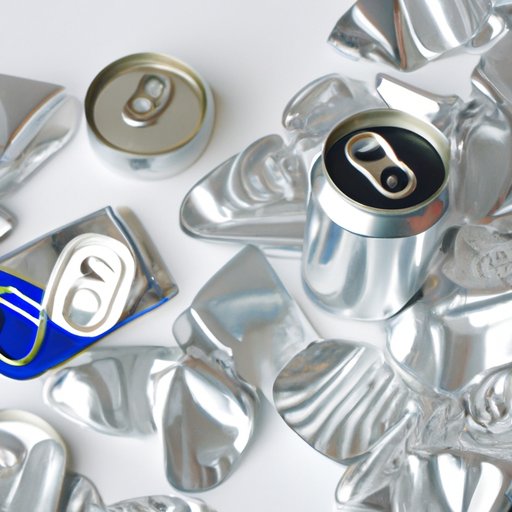Introduction
Aluminum recycling is the process of collecting used aluminum products and reusing them to create new products. The practice of aluminum recycling has been around since the early 1900s and continues to be an important way to reduce waste, conserve resources, and save money. In this article, we will explore how aluminum is recycled and the benefits, cost, and challenges associated with it.

Outlining the Process of Aluminum Recycling
The process of aluminum recycling begins when used aluminum products are collected from consumers or businesses. These products are then sorted and segregated according to their type and grade. Next, the aluminum is crushed into small pieces and melted down in a furnace. The molten aluminum is then cast into ingots, which are then rolled or extruded into new shapes. Finally, the new aluminum products are ready for sale and use.
Exploring the Benefits of Aluminum Recycling
Aluminum recycling offers numerous benefits both financially and environmentally. From a financial standpoint, aluminum recycling helps to reduce production costs by eliminating the need to purchase raw materials. It also reduces energy consumption as recycled aluminum requires less energy to produce than newly mined aluminum. Additionally, aluminum recycling can generate revenue through the sale of scrap metal.
From an environmental perspective, aluminum recycling helps to reduce air and water pollution associated with aluminum mining and manufacturing. It also conserves natural resources, as recycled aluminum does not require additional mining or processing. Furthermore, aluminum recycling helps to reduce landfill waste, as it prevents used aluminum items from ending up in landfills.

Examining the Environmental Impact of Aluminum Recycling
The environmental impact of aluminum recycling is largely positive. As mentioned above, recycling aluminum reduces the need for mining and manufacturing processes, which can be harmful to the environment. Additionally, aluminum recycling reduces the amount of energy needed to produce new aluminum products, further reducing its environmental impact. Finally, aluminum recycling helps to reduce the amount of greenhouse gases emitted into the atmosphere.
Investigating the Cost of Aluminum Recycling
The cost of aluminum recycling depends on several factors, including the type of aluminum being recycled, the quantity of aluminum being recycled, and the equipment and facilities needed to complete the process. Generally speaking, the initial investment required for aluminum recycling is relatively low compared to other types of recycling. However, there are ongoing costs associated with aluminum recycling, such as labor and utilities, that must be taken into consideration.
Highlighting the Role of Consumers in Aluminum Recycling
Consumers have an important role to play when it comes to aluminum recycling. By understanding the benefits of aluminum recycling and making the effort to recycle their own aluminum products, consumers can help to reduce the amount of aluminum waste sent to landfills and increase the amount of recycled aluminum available for new products. Additionally, consumers can look for ways to support local aluminum recyclers and encourage businesses to use recycled aluminum in their products.

Focusing on the Challenges of Aluminum Recycling
There are several challenges associated with aluminum recycling. One of the biggest challenges is the availability of materials. Many consumers are unaware of the importance of aluminum recycling and do not make the effort to recycle their own aluminum products. Additionally, access to recycling facilities can be a challenge, as many communities lack the necessary infrastructure. Finally, the cost of aluminum recycling can be prohibitive for some individuals and companies.

Discussing Innovations in Aluminum Recycling
Recent developments in technology have enabled more efficient aluminum recycling processes. For example, new machines have been designed to separate aluminum from other materials more quickly and effectively. Additionally, new techniques have been developed to maximize the amount of usable aluminum that can be extracted from recycled products. These advances have opened up new opportunities for aluminum recycling and helped to reduce the cost and environmental impact of the process.
Conclusion
Aluminum recycling can offer numerous benefits both financially and environmentally. It helps to reduce production costs, conserve resources, and reduce air and water pollution. Additionally, it can generate revenue through the sale of scrap metal. While there are some challenges associated with aluminum recycling, such as availability of materials and access to facilities, recent innovations in technology have made it easier and more cost-effective to recycle aluminum. Consumers have an important role to play in aluminum recycling and can help to reduce the amount of aluminum waste sent to landfills by recycling their own aluminum products.
In conclusion, aluminum recycling is an important practice that can help to reduce waste, conserve resources, and generate revenue. It is important for consumers to understand their role in aluminum recycling and be aware of the benefits, cost, and challenges associated with it. With the right resources and support, aluminum recycling can be an effective way to reduce our environmental impact and create a more sustainable future.

